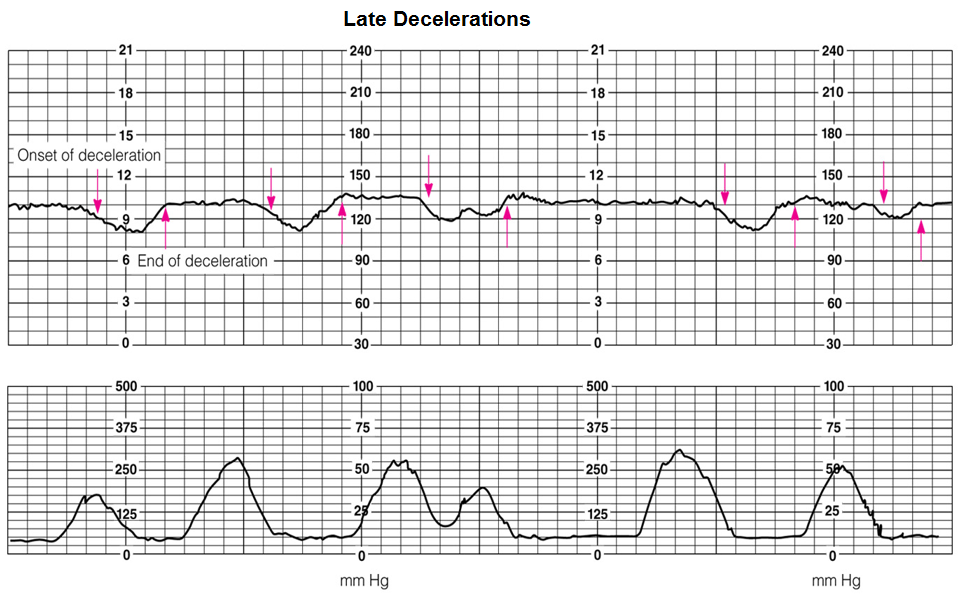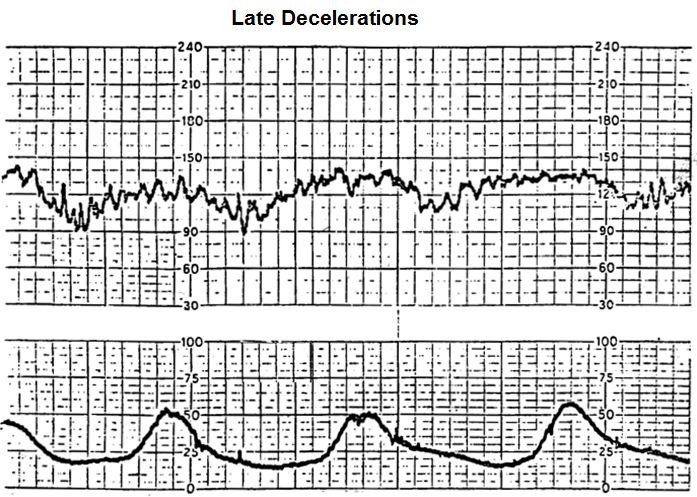Late Decelerations- Explained

Late decelerations are a serious condition in which the heart rate of a fetus lowers below baseline usually after the peak of a contraction and signifies impaired placental exchange of blood flow and oxygen to the fetus.
Late decelerations requires medical intervention on the part of a healthcare professional because the status of the infant is likely compromised.
With an infant and mother hooked up to electronic monitoring, we can see a chart of both the contractions of the mother's uterus and the heart rate of a fetus. If the baby's heart rate lowers after the peak of a contraction occurs, this signifies a late deceleration.
This is in contrast to early decelerations. An early deceleration is a benign condition in which the heart rate of a fetus lowers below baseline usually at the start of a contraction, reaches the lowest point (nadir) of heart rate at the peak of the contraction, and then the heart rate increases after the peak of a contraction. It's benign because it simply signifies the baby's head is being compressed during contractions. There is no compromise to the fetus in terms of blood flow or oxygen. And no medical intervention is needed. Early decelerations simply mimic a contraction.
Late decelerations, however, have the characteristic that they do not mimic a contraction. Unlike early decelerations where the fetus's heart rate is lowest at the peak of a contraction, with late decelerations, the heart rate drops even after the peak of contraction has occurred. So it isn't directly tied to the contraction itself and means that the health status of the fetus is compromised. The specific term is called uteroplacental insufficiency, in which there is a lack of blood supply to the fetus. This requires medical intervention on the part of a healthcare professional such as a nurse to come up with ways to improve placental blood flow and fetal oxygenation. This may include such things as giving fluid to the infant, giving the mother oxygen to increase oxygenation, or sitting the mother in an upright position to ease lung expansion.
Just as with early decelerations, late decelerations return to baseline after the contraction has ended. Baseline is the usual number of beats per minute of the heart that the fetus has. Even though it may vary around a certain number, it is always defined by a single numerical value.
So now that you know what late decelerations are and what causes it, let's see how to interpret them on a graph.
Below is a graph showing late decelerations.

So here we have 2 graphs. The bottom graph represents and is measuring the mother's uterine contractions, which are contractions of the uterus. Remember the contractions are measured while a woman is in labor. These graphs are taken while a a woman is in labor. So she is having contractions at these times. The top graph represents the heart rate of the fetus. Therefore, we are able to monitor the fetal heart rate during contractions, to see how the contractions are affecting the fetus.
The contractions are measured in mmHG, which you see at the bottom of the horizontal axis of the bottom graph. The heart rate, the top graph, is measured as the numerical beats per minute.
So, we first look at the contractions. Then we trace upwards to see what the fetal heart is doing during these contractions.
For the first contraction, all the way to the left, the onset of deceleration occurs before the peak of the contraction. However, after the peak of the contraction, the decelerations continue downward. This means that after the peak of the contraction has occurred, the baby's heart rate continues to plummet. This is the cardinal sign of a late deceleration. If the heart rate continues to fall even after the peak of the contraction has occurred, this is characterized as a late deceleration. Later on, as the contraction ends and levels up back to the uterine resting interval, you can see that the heart rate has returned to baseline, which is just about 130 beats per minute.
An early deceleration, just to give a contrast reference, mimics a contraction. The greatest deceleration of heart rate occurs at the peak of the contraction. As the contraction decreases in amplitude, the heart rate then rises until it's back at baseline. But for a late deceleration, the heart rate continues to fall even after the peak of a contraction.
Let's now look at the second contraction, second leftmost contraction. This is one is a little different than the first. In the first contraction, the onset of decelerations was before the peak of the contraction. In the second contraction, the baby's heart is baseline all the way up to the peak of the contraction. It's after the peak of the contraction that the heart rate begins to decelerate. After the contraction is over, you once again see that the heart rate goes back to baseline.
All the other waveforms do something similar.
So this is late decelerations in a nutshell.
For this fetus, the baseline heart rate is about 130 beats per minute. During the peak of the contraction, you can see that the heart rate gets as low as about 111bpm. Therefore, that's a difference of 19 beats from the baseline. The rate decrease is rarely more than 30-40 bpm below the baseline. So a drop of bpm in the teens and 20s is normal.
Another graph showing late decelerations is shown below.

You can see again how for each of the peak of the contractions how the heart rate decelerates after all of them.
For late decelerations, the heart rate may begin deceleration before or after the peak of the contractions but what is common for all of them is that the heart rate continues to go down after the peak of the contraction.
Again, late decelerations are a serious sign and mean compromise to the fetus in terms of oxygenation. Medical
intervention is needed to ensure the well-being of the fetus and to make sure the fetus is getting enough fluid and oxygen.
Related Resources
Variable Decelerations- Explained
